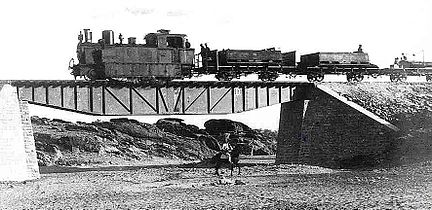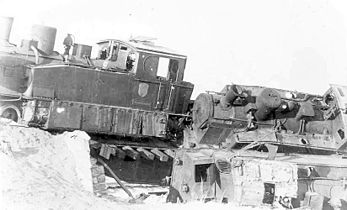South West African 2-8-0T
| GSWA Eight-Coupled Tank 2-8-0T South West African 2-8-0T | |||||||||||||||||||||||||||||||||||||||||||||||||||||||||||||||||||||
|---|---|---|---|---|---|---|---|---|---|---|---|---|---|---|---|---|---|---|---|---|---|---|---|---|---|---|---|---|---|---|---|---|---|---|---|---|---|---|---|---|---|---|---|---|---|---|---|---|---|---|---|---|---|---|---|---|---|---|---|---|---|---|---|---|---|---|---|---|---|
 Eight-coupled tank no. LE 15, c. 1912 | |||||||||||||||||||||||||||||||||||||||||||||||||||||||||||||||||||||
| |||||||||||||||||||||||||||||||||||||||||||||||||||||||||||||||||||||
| |||||||||||||||||||||||||||||||||||||||||||||||||||||||||||||||||||||
| |||||||||||||||||||||||||||||||||||||||||||||||||||||||||||||||||||||
| |||||||||||||||||||||||||||||||||||||||||||||||||||||||||||||||||||||
The South West African 2-8-0T of 1907 was a steam locomotive from the German South West Africa era.
Between 1907 and 1910, the Lüderitzbucht Eisenbahn (Lüderitzbucht Railway) in German South West Africa placed 23 tank locomotives with a 2-8-0 Consolidation type wheel arrangement in service. After the First World War, when all railways in the territory came under the administration of the South African Railways in 1922, four of these locomotives still survived. They were not classified or renumbered but were simply referred to as the Eight-Coupled Tanks.[1][2][3]
Lüderitzbucht Eisenbahn
Construction of a Cape gauge railway line from Lüderitzbucht on the Atlantic coast to Keetmanshoop commenced in 1905. The Lüderitzbucht Eisenbahn, later the Southern State Railway or Südbahn, was completed at a cost of £2,100,000 and was worked on behalf of the government by the German contractors, Lenz and Company.[3][4]
In 1909, a branch was constructed to Karasburg in the south from a junction at Seeheim, to the west of Keetmanshoop. Between 1910 and 1912, the North-South Railway or Nord-Südbahn, which connected with the Südbahn at Keetmanshoop, was constructed jointly by the German Imperial and the German South West Africa governments from Windhoek via Mariental, at a cost of £2,000,000.[4]
The original narrow gauge Swakopmund-Windhuk Staatsbahn or Nordbahn was regauged to Cape gauge from Windhoek to Karibib in 1911. Upon the completion of these three lines, Windhoek had rail links to two of the territory's ports. The extension from Prieska via Upington in the Union of South Africa to Karasburg in South West Africa was constructed by the Union government in 1914 and 1915, during the First World War.[4]
Manufacturer
In 1907, eight Cape Gauge tank locomotives with a 2-8-0 Consolidation type wheel arrangement were delivered to the Lüderitzbucht Eisenbahn by Orenstein & Koppel. They were numbered in the range from 1 to 8 and were all built in 1906. The first six of these locomotives were two-cylinder compound engines which were built to the Von Borries principles, the only compound locomotives of this design to serve in Southern Africa. The other two, numbers 7 and 8, were two-cylinder simple-expansion (simplex) engines.[1][3][5]
A second batch of thirteen locomotives was delivered from the same manufacturer between 1907 and 1910, built between 1907 and 1909 and numbered in the ranges from 9 to 18 and 20 to 21. They were all two-cylinder simplex locomotives, identical to the last two of the first batch. A final two locomotives of the same type were delivered, both built in 1910 and numbered 51 and 52.[1][3][5]
Two-cylinder compound expansion
In a compound locomotive, steam is expanded in phases. After being expanded in a high-pressure cylinder and having then lost pressure and given up part of its heat, it is exhausted into a larger-volume low-pressure cylinder for secondary expansion, after which it is exhausted through the smokebox. By comparison, in the more usual arrangement of simple expansion, steam is expanded just once in any one cylinder before being exhausted through the smokebox.[6]
A two-cylinder compound expansion locomotive using the Von Borries system of compounding has one high-pressure and one low-pressure cylinder. On the Eight-Coupled Tanks, the smaller high-pressure cylinder was on the right side of the engine and the bigger low-pressure cylinder on the left.[1][6]
The Von Borries system consisted of a combined intercepting and starting valve which, when starting, automatically admitted boiler steam into the receiver pipe between the high- and low-pressure cylinders. When the high-pressure cylinder began to exhaust steam into the receiver pipe, the starting valve was automatically closed and normal compound working ensued. A Von Borries compound could not work as simplex at starting because the high-pressure cylinder exhausted into a closed receiver pipe under all conditions. In this respect, the Von Borries system differed essentially from four-cylinder compound systems for locomotives, in which the two high-pressure cylinders could be made to exhaust to atmosphere by means of a relief valve, operated from the cab by the driver.[1]
Characteristics
The second pair of coupled wheels had a total sideplay of 13⁄32 inch (10 millimetres), while the trailing coupled wheels had a sideplay of 1 inch (25 millimetres). The engines bore number plates on their smokebox sides, inscribed "LE" and the engine number. Both versions of the type were equipped with dust shields over the coupled wheels and valve gear to protect the moving parts from blown sand in the Namib desert.[1]
Service
The locomotives were placed in service on the line between Lüderitzbucht and Keetmanshoop and on the lines from the latter north to Windhoek and south to Karasburg. Since the radius of operation of a tank locomotive is limited by the capacity of its small on-board coal bunker, these locomotives often ran with a small auxiliary tender coupled behind to extend their range.[1][2]
During the German South West Africa campaign in the First World War, the territory was taken over by the South African military. On 1 April 1922, all railways in the former German colony came under the administration of the South African Railways (SAR). Four of the simplex locomotives, numbers 10, 18, 20 and 21, survived to be taken onto the SAR roster. They retained their German colonial era engine numbers and were not classified by the SAR, but were simply referred to as the Eight-Coupled Tanks.[2][3]
The Eight-Coupled Tanks remained in SAR service in South West Africa into the late 1930s.[2]
Works numbers
The works numbers, years built, engine numbers and known disposition of the Eight-Coupled Tanks are shown in the table.[5]
Works no. |
Year |
GSWA no. |
1922 |
|---|---|---|---|
| 1870 | 1906 | 1 | |
| 1871 | 1906 | 2 | |
| 1872 | 1906 | 3 | |
| 1873 | 1906 | 4 | |
| 1874 | 1906 | 5 | |
| 1875 | 1906 | 6 | |
| 2069 | 1906 | 7 | |
| 2070 | 1906 | 8 | |
| 2356 | 1907 | 9 | |
| 2357 | 1907 | 10 | SAR |
| 2358 | 1907 | 11 | |
| 2359 | 1907 | 12 | |
| 2360 | 1907 | 13 | |
| 2361 | 1907 | 14 | |
| 2731 | 1908 | 15 | |
| 2732 | 1908 | 16 | |
| 2733 | 1908 | 17 | |
| 2734 | 1908 | 18 | SAR |
| 3182 | 1908 | 20 | SAR |
| 3183 | 1909 | 21 | SAR |
| 3184 | 1909 | 22 | |
| 4198 | 1910 | 51 | |
| 4199 | 1910 | 52 |
Illustration
-
Eight-coupled tank and tender on inaugural train at Seeheim
-
Eight-coupled tank on the Nord-Südbahn south of Windhoek
-
Eight-coupled tanks sabotaged by retreating German forces, c. 1915
References
- ^ a b c d e f g Espitalier, T.J.; Day, W.A.J. (1948). The Locomotive in South Africa - A Brief History of Railway Development. Chapter VII - South African Railways (Continued). South African Railways and Harbours Magazine, January 1948. pp. 30-31.
- ^ a b c d Paxton, Leith; Bourne, David (1985). Locomotives of the South African Railways (1st ed.). Cape Town: Struik. pp. 98–99, 149. ISBN 0869772112.
- ^ a b c d e Dulez, Jean A. (2012). Railways of Southern Africa 150 Years (Commemorating One Hundred and Fifty Years of Railways on the Sub-Continent – Complete Motive Power Classifications and Famous Trains – 1860–2011) (1st ed.). Garden View, Johannesburg, South Africa: Vidrail Productions. pp. 35, 380. ISBN 9 780620 512282.
- ^ a b c Espitalier, T.J.; Day, W.A.J. (1947). The Locomotive in South Africa - A Brief History of Railway Development. Chapter VII - South African Railways (Continued). South West Africa. South African Railways and Harbours Magazine, August 1947. pp. 667-668.
- ^ a b c Lieferverzeichnis O and K Dampfloks
- ^ a b Clark, Daniel Kinnear (1855). Railway Machinery. Glasgow: Blackie and Son Limited.



